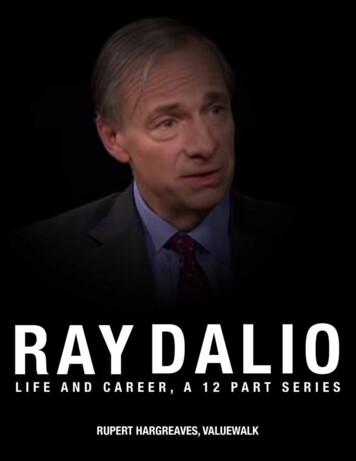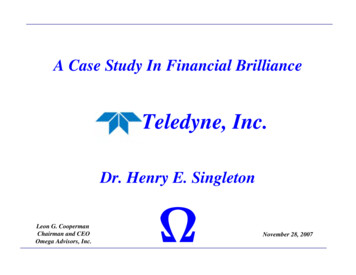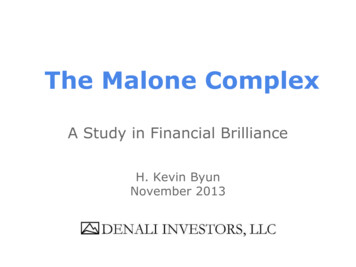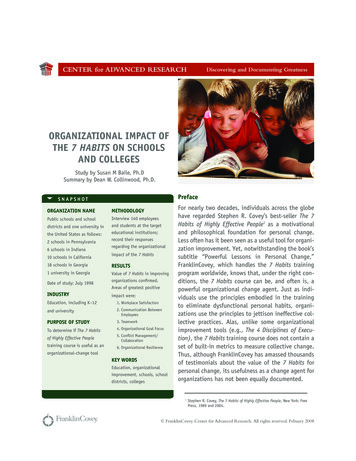
Transcription
Ray Dalio(C)ValueWalk2015 - All rights ReservedCharlieMunger11
Ray DalioIntroFounded by Ray Dalio during 1975 from his two-bedroom apartment, today Bridgewater manages 169 billion fora wide array of institutional clients, including foreign governments and central banks, corporate and public pensionfunds.Over its 40-year history, Bridgewater has been recognized as a top-performing manager and an industry innovator.The fund manager was one of the few firms to register a positive performance during the 2008 financial crisis.In 2012, Ray Dalio appeared on the annual Time 100 list of the 100 most influential people in the world. And he madeBloomberg Markets’ list of the 50 Most Influential people during 2011 and 2012. According to Forbes, at time ofwriting (06/12/2015) Ray Dalio is worth 15.4 billion, making him the 29th richest person in the United States, 2ndrichest hedge fund manager and #60 richest in the world.(C)ValueWalk2015 - All rights ReservedCharlieMunger22
Ray DalioPart One(C)ValueWalk2015 - All rights ReservedCharlieMunger3
Ray DalioThe Pre-Bridgewater YearsRay Dalio was born in Jackson Heights, Queens during 1949. At the time, his family had no connections to the financeindustry. Ray’s father was a jazz musician who played the clarinet and saxophone at Manhattan jazz clubs. Ray Daliofirst started to gain an interest in the financial world when he was around 12. At the time, he was working as a caddyat the Links Golf Club, which was close to his school. Wall Streeters used to frequent the club and Dalio soon startedto learn.It was the 1960s and the market was booming. Dalio, who was only 12 at the time, was obsessed with the talk on thegolf course, which usually revolved around the markets.Ray picked up tips and advice from the club’s members and soon purchased his first stock; Northeastern Airlines.At 5 per share, Northeastern was the only stock Dalio could afford, he had saved up 300 from his job at the golfcourse.Ray was extremely lucky with this first pick. Soon after he purchased the stock, Northeastern received a takeover atthree times the price Dalio had paid for it. Ray Dalio was hooked immediately. In his own words, “I figured that thiswas an easy game.”HookedRay Dalio’s career in finance started at this point. After the Northeastern trade, he was hooked and immediatelystarted to look for other investments. This time around, Ray paid close attention to the companies he was looking at.The young Dalio began reading annual reports and sought out advice from older, more experienced investors. Overthe years between his first investment and starting college Ray built the foundations for his success at Bridgewater. Helearned through trial and error and discovered that the only way to outperform is to be right when others are wrong.What’s more, when he had an idea, Dalio found it best to ask the opinions of other investors, asking them to critiquehis reasoning.By doing his research, seeking out other opinions and studying market movements, by the time Dalio went to college,he had built a stock portfolio worth several thousand dollars. After achieving an excellent academic record at college,Ray Dalio went on to win admission to Harvard Business School.Harvard Business SchoolBetween college and graduate school, during the summer of 1971, Dalio worked as a clerk on the floor of the NewYork Stock Exchange. From his position on the floor, Dalio was able to see firsthand the effects of Nixon’s decisionto abandon the gold standard. The day after this decision, stock prices jumped 33%.As Dalio already had a solid grasp of the financial markets, after his first year at Harvard, he spent the summer trading commodities at Merrill Lynch for his own account. Dalio had taken a keen interest commodity trading while incollege. He was intrigued by the high level of leverage that could be used to trade, along with the outsized profits incomparison to stock trading. In other words, Dalio saw the opportunity to earn a considerable profit on a minimalinvestment. Taking the experience from Merrill, Dalio returned to Harvard, and, with a group of friends, set up asmall commodity trading company called Bridgewater Associates.(C)ValueWalk2015 - All rights ReservedCharlieMunger4
Ray DalioDalio in demandUnfortunately, this Bridgewater Associates didn’t really take off, but Dalio’s experience running the business, as wellas his work at Merrill didn’t go unnoticed. After leaving Harvard, Dalio himself became a sought-after commodity; aHarvard graduate with commodity trading experience.Dalio went to work for a Dominick & Dominick, LLC after leaving Harvard but only stayed for a year, before movingto Shearson Hayden Stone, the brokerage firm run by Sanford Weill -- who later went on to help create CitiGroup.At Shearson, Dalio worked in the commodity-futures department. His job; to advise farmers, cattle ranchers and grainproducers in particular on how to hedge risks. By his own account, Dalio was frustrated with Shearson’s managementstructure, which ultimately lost him his job. From The New Yorker:“On New Year’s Eve in 1974, Dalio went out drinking with his departmental boss, got into adisagreement, and slugged him. About the same time, at the annual convention of theCalifornia Food & Grain Growers’ Association, he paid an exotic dancer to drop her cloak infront of the crowd.”Bridgewater take twoDespite his disgrace, a number of Dalio’s clients continued to support him and he persuaded some to hire him as aconsultant when he departed Shearson. Ray Dalio bought his old commodity trading company for Harvard back tolife and Bridgewater Associates was reborn. Trading out of his two-bedroom apartment at the age of 26, Dalio’s newbusiness advised a few corporate clients on currency exchange and interest rate risks.To begin with, there was nothing special about Bridgewater, but Dalio’s clients soon started to boast of the impressivereturns he was helping them to generate. More potential clients started to approach Dalio. Bridgewater’s big breakcame when McDonald’s and one of its major suppliers signed on as clients, and Bridgewater began to grow dramatically.(C)ValueWalk2015 - All rights ReservedCharlieMunger5
Ray DalioPart two(C)ValueWalk2015 - All rights ReservedCharlieMunger6
Ray DalioBridgewater GrowsBridgewater began to grow rapidly during 1985.After signing up McDonald’s and one of the company’s major suppliers as a client, Ray Dalio persuaded the WorldBank’s employee retirement fund to let Bridgewater manage some of its capital. Then, during 1989 Bridgewater signedup Kodak’s retirement system.In Bridgewater’s early days, the fund’s philosophy was much the same as it is today. The fund sought to achieve steadyreturns by investing in a variety of markets such as U.S. and international bonds, using leverage to boost its exposure.Take, for example, Bridgewater’s Pure Alpha fund. Ray Dalio likes to spread his bets on the market and will typicallyhave 30 to 40 different trades on at any one time.It’s always a matter of controlling risk,” Dalio has said in the past.“I’m always trying tofigure out my probability of knowing,” and“given that I’m never sure, I don’t want to haveany concentrated bets.”Achieving alphaBridgewater usually places “spread” bets, where the fund will purchase one security it considers undervalued and selling short another one it considers overvalued.The returns from spread bets tend to be uncorrelated with the overall market, and, this is the key driver behind Bridgewater’s unparalleled ability to achieve alpha.For instance, during the “dot-com bubble” and the following September 11, 2001 terrorist attacks, Bridgewater held(C)ValueWalk2015 - All rights ReservedCharlieMunger7
Ray Daliosteady. In 2000, 2001 and 2002 Bridgewater reported strongly noncorrelated performance, -3.5%, 6.1% and 14.2%respectively. During 2008, the fund reported a positive performance of 8.7% while the S&P 500 fell 38.49%.Earlier this year, within Bridgewater’s monthly presentation to clients, the company discussed their method of separating alpha, or manager skill, from beta, or the general market environment, the key principle behind the Pure Alphastrategy.Pure AlphaBridgewater’s Pure Alpha strategies together manage 81 billion, making the two --Pure Alpha and Pure Alpha MajorMarkets -- the largest funds managed by Bridgewater. The group’s All Weather strategy comes in a close second with 79 billion in assets.The Pure Alpha portfolio is spread across eight different asset subcategories: Developed Currencies, Nominal InterestRates (Directional), Nominal Interest Rates (Spread), Inflation Linked Bonds, Sovereigns and Corporate Credit, Equities, Commodities and Emerging Currencies. The Nominal Interest Rates group is by far the largest of the portfoliowith around of a third of Pure Alpha’s AUM invested.Bridgewater’s Pure Alpha strategy targets 12% volatility and has, since 1991, returned 9.91% per year excluding fees.Far from simpleMost of the world’s most successful hedge fund managers have been able to achieve outsized returns by placing largedirectional bets on one security, or asset class.But this strategy would be too simple for Bridgewater.The firm’s Pure Alpha strategy is far from simple. Indeed, Bridgewater uses a complex set to strategies across a broadportfolio to achieve results. Ideas are discussed with the fund’s investment officers and then carefully monitored toensure that they are performing in a manner consistent with expectations.Still, even with 40 years’ experience managing money Bridgewater still makes mistakes, and, by management’s ownadmission, even Bridgewater’s best ideas are only right around 60% of the time: “without significant diversificationour results would inevitably produce periods of unacceptable risk. Therefore, we have assembled a portfolio with asufficient number of uncorrelated strategies to ensure the reliability of our investment returns.”As a result of Bridgewater’s diversification, managers expect the Pure Alpha fund to make money in five out of sixyears:“Pure Alpha is a highly diversified set of uncorrelated alpha return streams.Our positions in each market are driven by a systematic assessment of theunique underlying fundamental drivers of that market. Our performance isdriven primarily by our winning percentage across these markets. Our winning percentage normally oscillates within a range of roughly 40% to 80%with a norm of about 60%.”(C)ValueWalk2015 - All rights ReservedCharlieMunger8
Ray Dalio“In recent years outperformance has remained uncorrelated to other markets and asset managers. Our alpha returns are independent from the returns of other marketsbecause we explicitly separate our alpha from our beta and have no bias to be longor short any particular market. And our returns are uncorrelated to the returns ofother managers because our skill in trading market has no relation to the skill of othermanagers, and to the extent that other manager have embedded beta exposures we areuncorrelated to those betas.” -- Bridgewater 2013 Strategic Report(C)ValueWalk2015 - All rights ReservedCharlieMunger9
Ray DalioPart Three(C)ValueWalk2015 - All rights ReservedCharlieMunger10
Ray DalioInvestment StrategiesAlongside its key Pure Alpha strategy, Bridgewater’s second largest fund, in terms of AUM, is its All Weather fund.As described in Bridgewater’s “The All Weather Story”:“The principles behind All Weather relate to answering a deceptively straight-forwardquestion explored by Ray with co-Chief Investment Officer Bob Prince and otherearly colleagues at Bridgewater - what kind of investment portfolio would you holdthat would perform well across all environments, be it a devaluation or somethingcompletely different?”While Bridgewater’s Pure Alpha strategy targets, alpha, the group’s All Weather strategy targets beta. All Weather isbased around the principle that different asset classes act differently in different market environments. Therefore,by balancing asset exposure and assets classes, the fund can outperform with limited risk. All Weather is designed toperform across all economic environments.All Weather exampleAn example is the best way to highlight the benefits of the All Weather strategy.During 2012, every quarter saw a different market environment with various risks and a broad range of opportunities.Specifically, during the first quarter of the year, global growth picked up, the ECB’s LTRO programs buoyed European banks and cyclical assets such as equities while oil surged. Defensive assets like bonds underperformed.By balancing its exposure, the All Weather fund gained 3.6% during the first quarter of 2012. The second quarter sawa reversal of gains in cyclical assets, defensive bonds outperformed while equities struggled. Once again, All Weatherproduced a positive return of 3.4%.Q3 2012 was a good quarter for all assets. Central Bank easing pushed both defensive and cyclical assets higher. AllWeather returned 5.5% during the period. During the final quarter of 2012, the markets didn’t do much, and AllWeather produced a return on 1.5%.Since its inception during 1996, the All Weather has produced a total return of 10.4% per annum, beating the returnson a conventional portfolio by around 3.3%.This is a simplified description of the All Weather strategy and doesn’t do the strategy justice. However, I’m going totake a closer look at this strategy further on in the series.Alpha/beta separationI’ve given a run-down of Bridgewater’s two key strategies so early on in this series as I wanted to give an idea of whatkind of style Bridgewater uses to manage its funds. The two key funds, All Weather and Pure Alpha are managed in ahighly sophisticated way, using quant models to calculate and predict returns.Bridgewater has also developed several “innovative investment strategies” one of which is the separation of alpha andbeta, a strategy few other managers have been able to f
Ray Dalio bought his old commodity trading company for Harvard back to life and Bridgewater Associates was reborn. Trading out of his two-bedroom apartment at the age of 26, Dalio’s new business advised a few corporate clients on currency exchange and interest rate risks. To begin with, there was nothing special about Bridgewater, but Dalio’s clients soon started to boast of the impressive .











